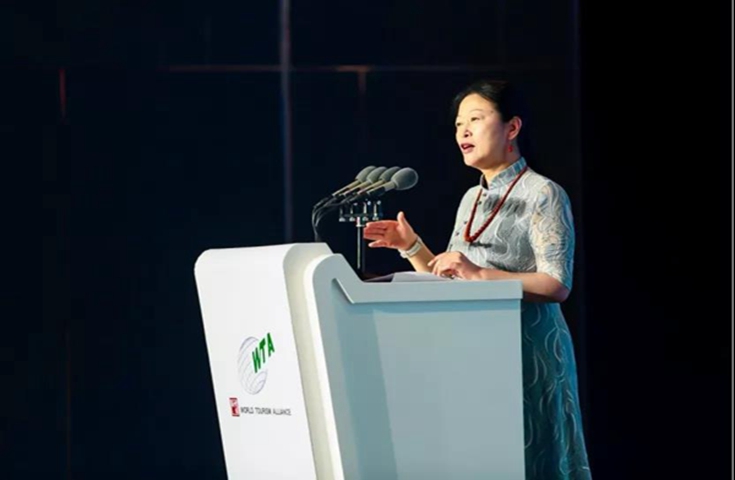2021-07-22
On July 22, 2021, the World Tourism Alliance Members’ Day 2021 organized by Harbin Municipal Bureau of Culture, Broadcasting, Television and Tourism, a member of WTA, was held in Harbin, Heilongjiang Province, China. Centering around the theme of “Festival Brands Building and City Tourism Development”, experts and scholars from the members of WTA including Harbin Municipal Bureau of Culture, Broadcasting, Television and Tourism, the School of Tourism Management at Sun Yat-sen University, UnionPay International, Spring Tour and Tuniu.com conducted interaction and communication with over 100 guests present.
On the WTA Members’ Day, Zhou Weihong, Director of Shanghai Spring International Travel Service (Group) Co., Ltd. and Deputy General Manager of Shanghai Spring International Travel Service Co., Ltd., shared the tailored festival tourism products and routes developed by Spring Tour for Shanghai, and analyzed the significance and value of building and organizing festival activities at cities as tourism destinations.
Sharers | Zhou Weihong
Director of Shanghai Spring International Travel Service (Group) Co., Ltd. and Deputy General Manager of Shanghai Spring International Travel Service Co., Ltd.
Prepared Based on Recordings | World Tourism Alliance
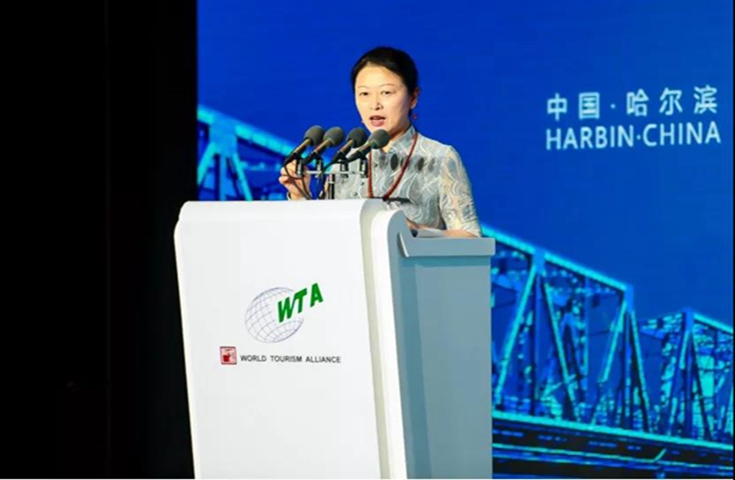
Distinguished leaders and WTA partners,
Good morning! Last night, I watched an attractive and charming promotional film of Harbin, and today I heard Director Lan said, “Harbin covers an area of 53,000 square kilometers.” I would feel embarrassed to say that I come from “big” Shanghai – as you know, Shanghai is only about one-eighth of Harbin in area.
As a native enterprise of Shanghai, what can we do for Shanghai’s destination tourism? I think this may also be the task given to me by the Secretary-General Liu Shijun. I have no theoretical support but only daily practice.

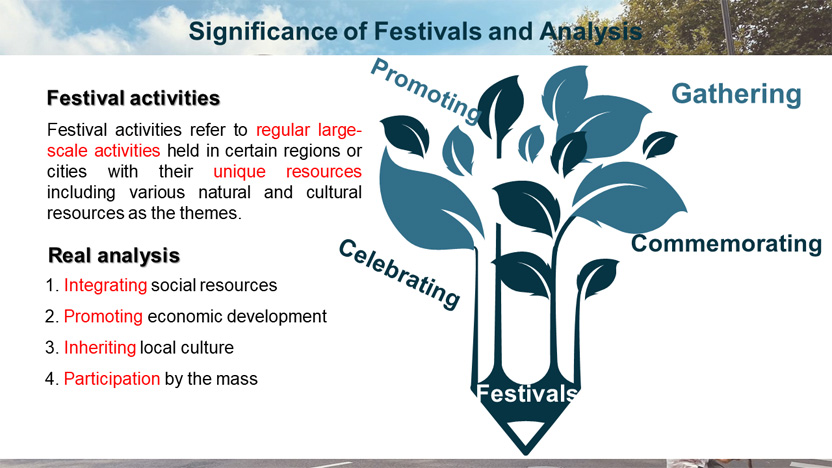
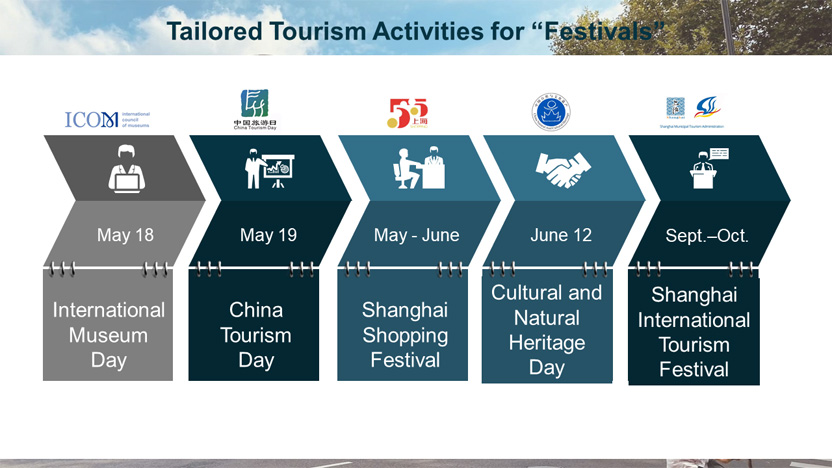
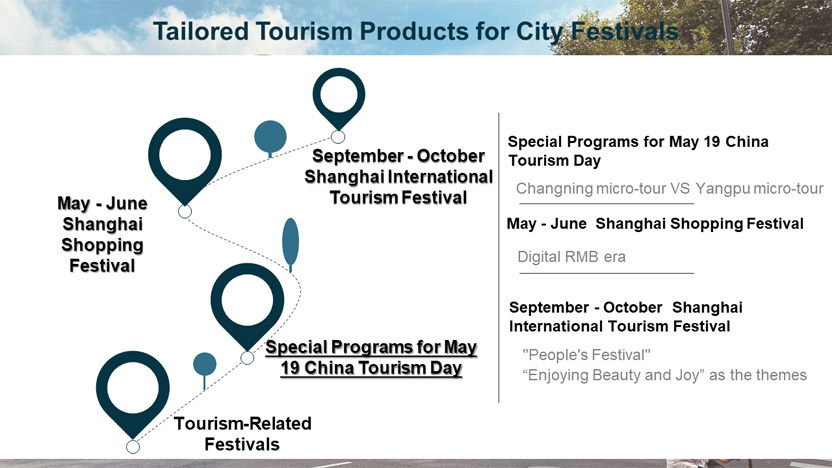
My sharing is mainly in five aspects, that is, these five aspects as shown in PPT. But I will not talk about the first and second aspects as just now many experts have talked about them.My understanding of the festivals is based on our experience in developing tourism destination products for Shanghai, as what we are developing is pure urban tourism. I think Harbin is not completely the same case, as its tourism ecology is more diversified.Tailor-made festivals in Shanghai, I think, are roughly related to the following programs. Some are state-level ones, and some are created by Shanghai itself. So, as a tourism enterprise in Shanghai, what did we do and how did we participate in them?Generally, we participated in the following events: “China Tourism Day” and Shanghai Shopping Festival in Shanghai this year – we used to think the shopping festival was part of commerce & trade system, but now we think it belongs to business, and constitutes a part of the broad business. So we became one of the most important participants of Shanghai Shopping Festival – then Shanghai International Tourism Festival.
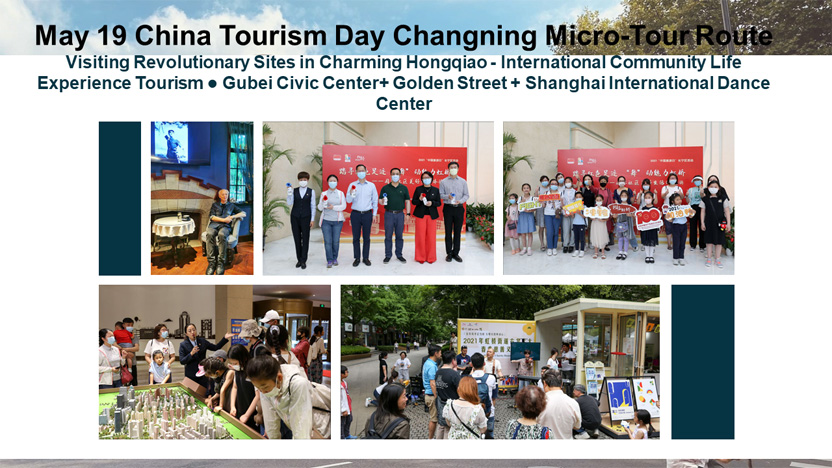
As to the “China Tourism Day” this year, we organized two programs. The first one was developed for Changning District. But it wasn’t held on the very day of May 19, but the first weekend before May 19. The other program was developed for Yangpu District. I think these two programs are different: Changning District is close to Hongqiao Airport – I remember a question of Politics in my senior middle school entrance examination was just about Hongqiao being the place where the Chinese government granted the first piece of land under leasehold – so it determines that the area is highly international and open. The program we developed for Changning District is called “Going into an International City”. How could we as a tourist enterprise develop such an event which seems to be a part of government report? What we did was as follows: First, we gathered at Mausoleum of Soong Ching Ling, which is undoubtedly internationalized; Second, we visited Gubei Civic Center. It sounds magnificent and lofty, but in other words, it actually may also be called a “neighborhood committee”. Gubei, where 50% of the residents are from abroad, is one of the two most internationalized landmarks in Shanghai at present. The General Secretary of CPC went there in his visit to Shanghai a few years ago. There we heard a representation from the director of the magnificent and lofty neighborhood committee, who was recognized as a national model worker this year, used to work in a foreign company and spoke very fluent English. So what kind of facilities are there in such a neighborhood committee? What kind of service does it provide? Then, how about our third destination? Took Metro Line 15 for one stop so that we could experience the unmanned subway trains representing the cutting-edge modern technology. The last destination was Shanghai International Dance Center. Dancing has no boundaries. So what did we do in this place? Instead of sitting in the hall to enjoy a performance as we did last night, we were engaged in a small exchange about dance culture. We invited Professor Ling Guiming, who played Da Chun for the first time in the White-Haired Girl performed by Shanghai Ballet, to give a lecture. The 70-year-old gentleman sat there and talked about his experience in life and dancing study as well as his understanding of that character in a charming manner. After this product was launched, more than a dozen families were enrolled in less than one hour. And from that day on, we have launched the product on every weekend. The Shanghai International Dance Center has two famous dance troupes, one being Shanghai Ballet and the other being Shanghai Dance Theatre. Both of them are well-known throughout the country.
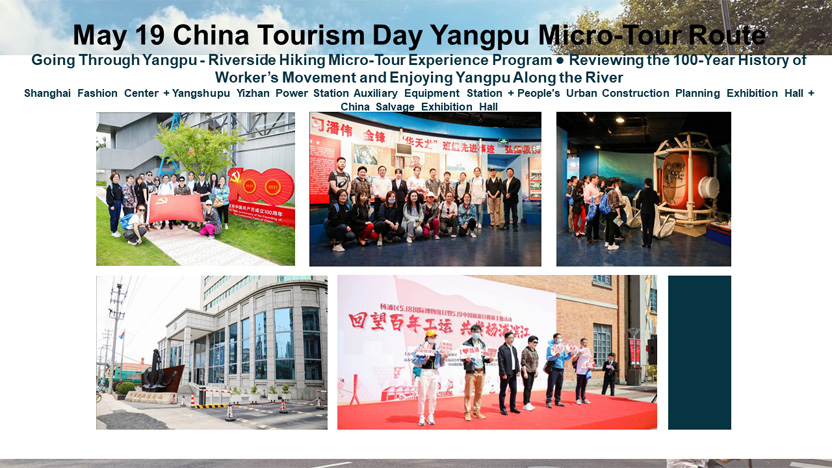
The program we developed for Yangpu District is called “Going Through Yangpu”. It was started last year. Shanghai has two traditional industrial areas, one in Putuo District and another at the Riverside of Yangpu District. With the acceleration of city transformation, the Riverside of Yangpu District has changed from an industrial “rusty belt” to a lifestyle “show belt”. How did the transformation occur? The General Secretary of CPC said here: “People’s cities are built by people and for the people.” How can the tourism enterprises and tour guides tell this story well? So we have been developing (this product) for the Riverside of Yangpu District since last year. Now on every weekend, you may see tour groups walking there and listening to the story of Shanghai’s city transformation.
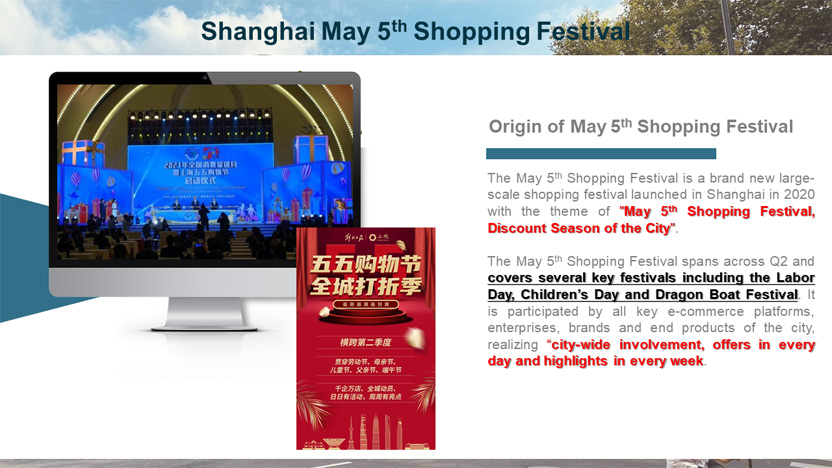
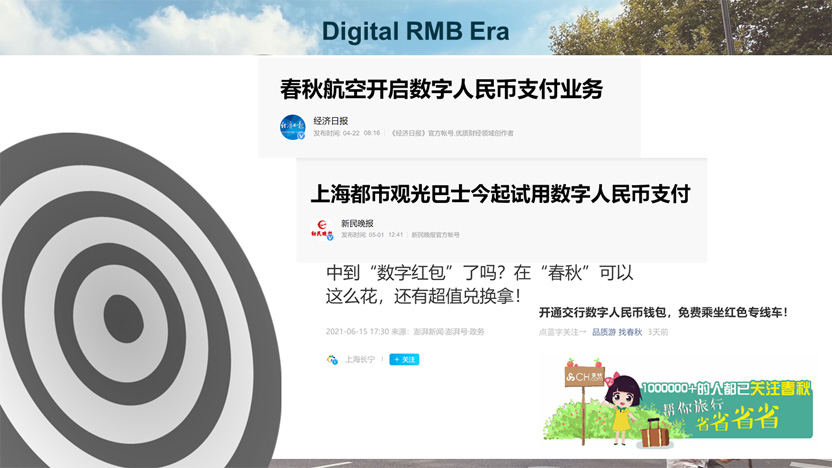
May 5th Shopping Festival. In the second half of last year, Shanghai became one of the cities testing digital RMB. I think the tourism enterprises never want to be left behind the trend. On the first day of May 5th Shopping Festival this year, we began to test the use of digital RMB for tourism – I think tourism enterprises must grasp the fashion and technology firmly. Up to now, we have opened up digital RMB payment in all channels, and are working with the Bank of Communications on digital RMB projects.
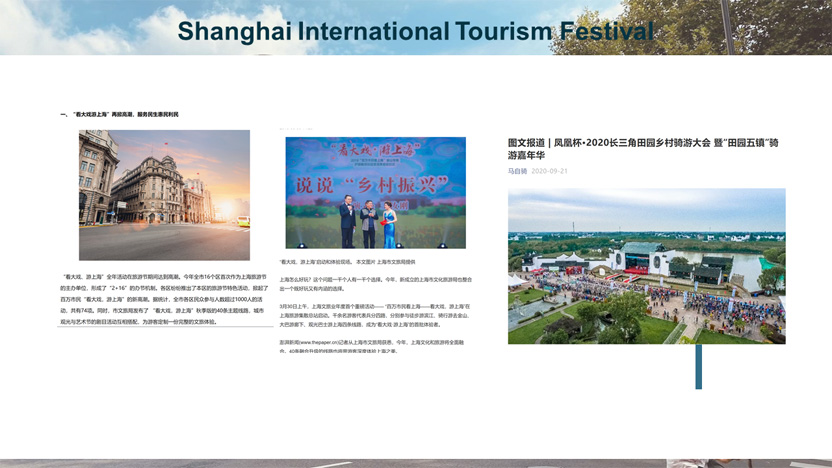
Shanghai International Tourism Festival. In 2019, there was a program called “enjoying plays (visiting Shanghai)”. Spring Tour is a grass-roots enterprise, so we never first ask the government, “How many funds do you give me?” Instead, we always ask, “How many tasks do you give me?” As we all know, the Shanghai people are a little proud. In fact, they don’t understand or have in interest in many plays. How could we make them interested? The young people don’t even like Shanghai opera. But they are very interested in Dunhuang. In 2019, Mao Shanyu, a famous artist, performed the Shanghai opera Daughter of Dunhuang, telling the story of Fan Jinshi, a female from Shanghai, devoting her life to her career in Dunhuang. Therefore, we combined Dunhuang tourism product with Shanghai opera performance, and many tourists once been to Dunhuang bought tickets for the Daughter of Dunhuang. During the Shanghai Tourism Festival last year, we included rural cycling considering the theme of rural revitalization.
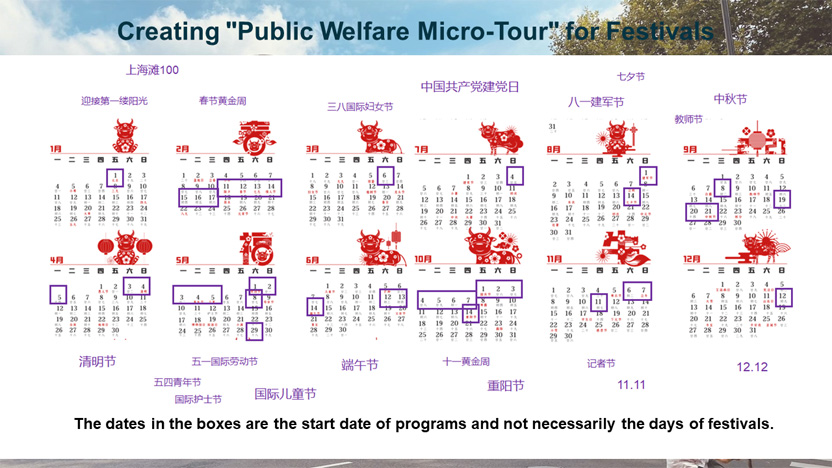
The next part is about small festivals throughout the year, which help the city maintain the atmosphere of tourism festivals. Let’s take a look at the calendar with marks made by our colleagues. These dates in purple frames are not necessarily the very days of festivals, but have managed to give every month a “tourism festival”.
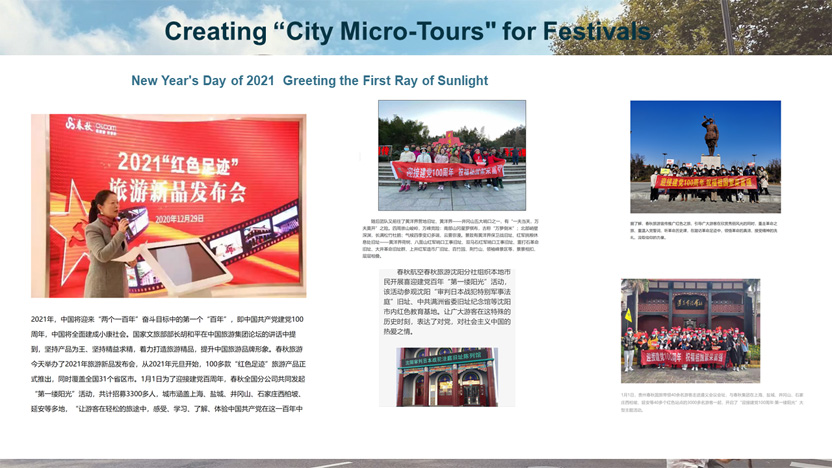
On the New Year’s Day, we launched a new program called “Greeting the First Ray of Sunlight”- we will organize the program next year with our 47 branches across China and Shanghai Head Office – and over one thousand people attended the program in Shanghai. How did we organize this program? It started from Changning District. Why do I always talk about Changning District? Because our Head Office is based in Changning. I think our contribution to Changning is not only tax. It has a very small area, only 20 square kilometers, with relatively scarce tourism resources. This year, the dredging works of Suzhou River are completed. As the district government offers such good resource, as a tourism enterprise we should make good use of it. The route of the program passed East China University of Political Science and Law. This university has a history of more than one hundred years. In the history of revolution, when Shanghai was liberated, the first place where the People’s Liberation Army led by Chen Yi camped was East China University of Political Science and Law, also known as St. John’s University at the time. Then we went to Yuyuan Road with a history of a hundred years. What did we visit there? The former Site of the Editorial Department of Bolshevik, the former residence of Qian Xuesen, and then the site of 2nd National Congress of the Chinese Communist Party and the site of 1st National Congress of the Chinese Communist Party – it was not open to the public at that time, and we could only walk around. Half a year later we formed an indissoluble bond with the site of the 1st National Congress of the Chinese Communist Party. At that time, this program aroused widespread response in Shanghai media. So next year, with which theme will we start the program on the day? We have started communication and discussion about ten days ago, and determined the basic ideas and partners.
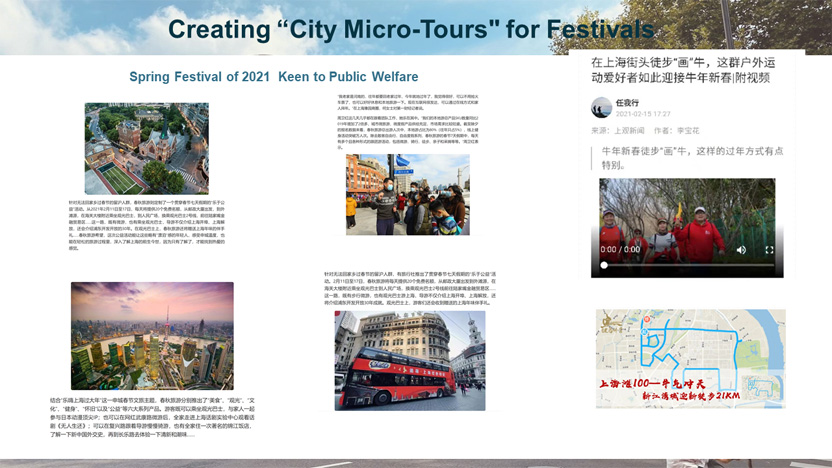
The Spring Festival of this year is “pretty terrible” for tourism as a new phrase “staying put during Spring Festival” was presented, which means that people couldn’t go out or return hometown. What could Shanghai do? We launched a program named “Keen to Public Welfare”. The program was designed for a targeted group of people. There were many “new Shanghai people” staying in Shanghai who didn’t know the hundred-year history of Shanghai – we only introduced the history in the past 100 years, but not longer because we know that we can’t compete with Xi ‘an or Beijing in terms of a longer history. In that program, we chose the form of “micro-tour”. As for Shanghai micro-tour, you can check it online. There are many products and introductions. What was the product we chose? It began with the Post Office Building, which was a symbol of the history of China’s postal industry in the late Qing Dynasty. Then we went along Suzhou River and got to Yuanmingyuan Road where the first western building was constructed after Shanghai was forced to open to the west due to Opium War which was started in 1840 and the unequal Sino-British treaty signed thereafter. Then, we took the sightseeing bus No.2 to Lujiazui to appreciate the 30 years of development and opening of Pudong. The 100-year history was represented in the three-hour journey so that these new Shanghai people could get closer to the city. In addition, we also organized some hiking programs. We chose a community called “Xinjiangwancheng”, which is not a tourist area. We hiked in a program called “Towards the Year of the Ox” on the fifth day of the Chinese New Year. We added more elements to this program, such as “Enjoying wonderful foods” – as eating and drinking can always make some sense to tourism. Shanghai has no high mountain, but only a less than 100m-tall Mount Sheshan. We also climbed the Mount. On the fifth day of the Chinese New Year, we also made lanterns to make wishes. This is what we did for the Spring Festival.

Then I will introduce what we developed throughout the year. As you can see, on Women’s Day (March 8), we walked the Julu Road – one of the sixty-four roads which are never widened in Shanghai. We can make use each of the roads. Why did we choose this road? Because all the tourists were female. At the end of our trip, we visited the office of the Shanghai Writers’ Association. It also has a better name, “God of Love Garden”, as it is a very romantic work created by Hungarian architect Hudec who worked and lived in Shanghai for more than 20 years. Most people can’t get inside, but with our program, the tourists were allowed to get inside. In addition to this “God of Love Garden”, there is also this building, which was a gift given by a gentleman to his deeply-loved wife on her 40-year birthday. This product was also sold out within about two hours after launch.
On the Tomb-Sweeping Day, the products were designed to recall the past. We introduced three routes to make every day of the three-day holiday different. The first route was about “Jews in Shanghai”. It was about a period of history which should not be forgotten, and reflected Shanghai’s humanity, kindness and tolerance. The second route was about the area where the “League of the Left-Wing Writers” was located and the place where Lu Xun worked and lived in Duolun Road. The third route was about “Shanghai Liberation” along the Suzhou River and included the Monument to the People’s Heroes.
As to the Labor Day and Chinese Youth Day (May 4), we launched the “Labor Being the Most Glorious” program on the Labor Day. Shanghai has the most concentrated modern industry. One of the winners of this year’s July 1 Medal is Huang Baomei, who used to work in a plant called the “No.17 Wool Mill” at the Riverside of Yangpu. The No.17 Wool Mill was actually a Japanese wool mill in the 1920s and 1930s. We focused on the story of the working class in Shanghai after liberation. After launch, the product won a warm welcome immediately from the Chinese Communist Youth League committees, teachers and students.
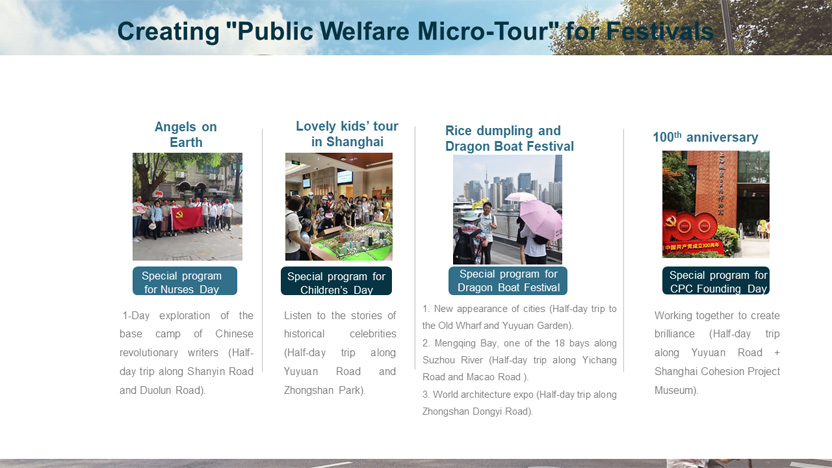
On the International Nurses Day, we developed the “Angels on Earth” program designed for young nurses. Considering most of the nurses are female, which route did we arrange? In fact, it looked very close to the “Gift for the Goddess” – Duolun Road. We also added the Tianai Road. There is a road in Shanghai called Tianai Road, which is very romantic, but very short. We always use Firmiana Simplex as shade tree in Shanghai, but very straight Metasequoia glyptostroboides trees are planted there. There are many details in the product to enjoy. We feel that we should communicate this love to our nurses.
What can we do on the International Children’s Day? We also travelled along the Yuyuan Road and mainly introduced Fu Lei’s former residence and Fu Lei’s Family Letters. We made the tourists think how the father and son could communicate and respect each other while maintaining their own thoughts.
On the Dragon Boat Festival, we combined the story of old town with the ecological reconstruction of Suzhou River.
On the CPC Founding Day, we didn’t go to the site of 1st National Congress of the Chinese Communist Party, because there were too many people. Instead, we went to the Shanghai Cohesion Project Museum in Zhongshan Park to see how CPC members and CPC organizations demonstrated their leading role in the new era.
We will launch many more programs this year.
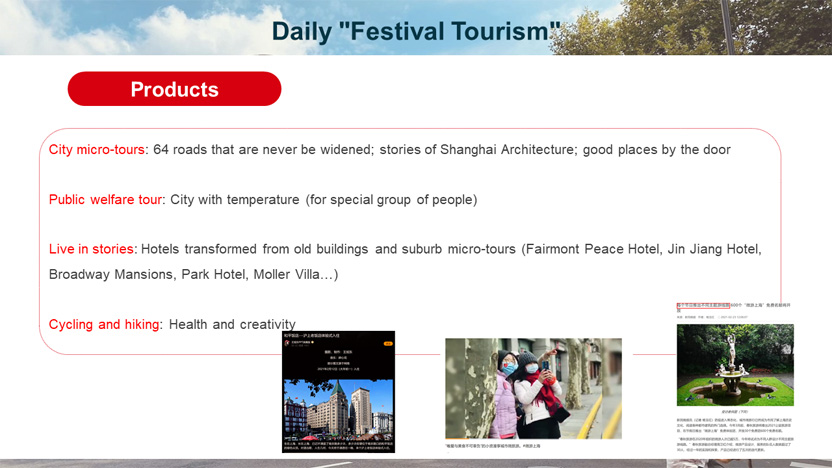
Our city has a very small area, but we should explore it in depth and breadth. Therefore, we set eyes on the “64 roads that are never be widened”, “stories of Shanghai Architecture” and “good places by the door” – which are tasks given by Shanghai Municipal Administration of Culture and Tourism to us and the entire tourism industry, and we took the opportunity.
We hold the idea of “travel with temperature”, so we also launched public welfare programs for special people.
Besides, we also “live in stories” – there are many hotels transformed from old buildings in Shanghai, which cost over RMB 1,000 or even RMB 2,000, 3,000 and 4,000 per night to stay, but were still well welcomed.
The “Cycling and Hiking” in the city also caters to the health needs of young people nowadays.
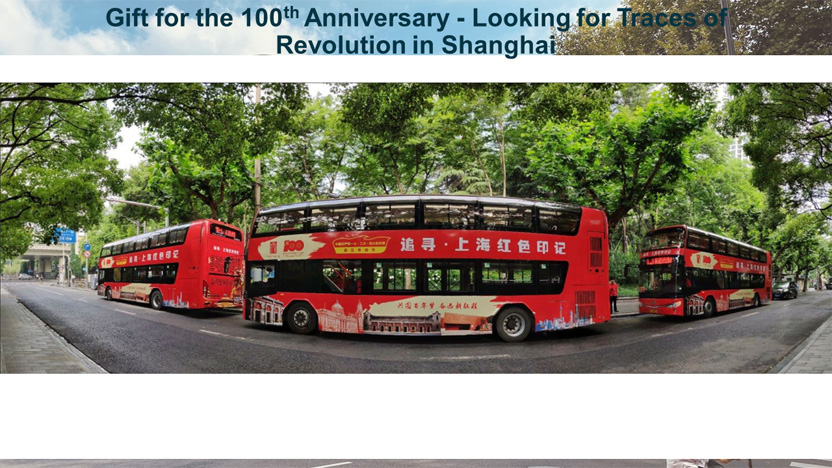
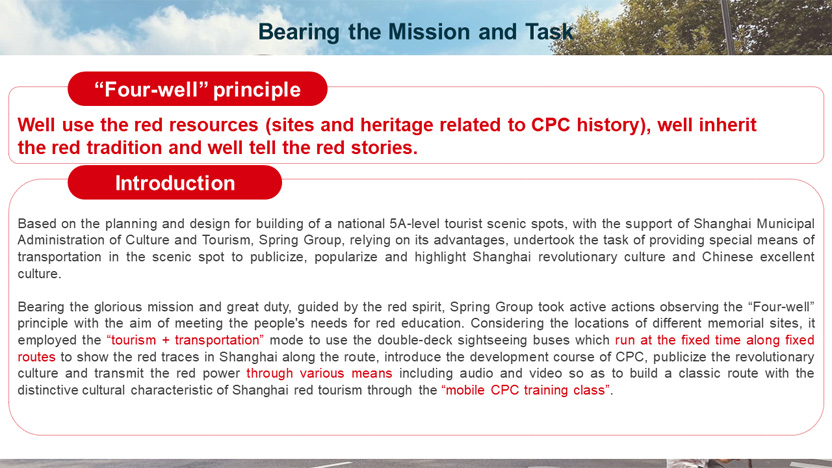
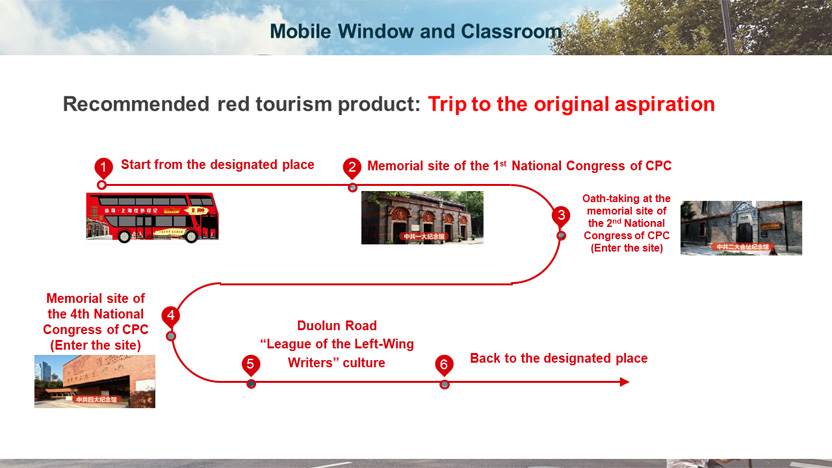

The last one, “red (revolution) tourism route”. Why do I share it here? It’s because I think festivals can’t be limited to a few days, a week or a month. We should create a never-ending festival atmosphere. This red tourism route was born with the building of the first 5A-level red scenic spot in Shanghai. I attended the meeting about the 5A-level red scenic spot at about 4 o’clock in the afternoon of February 24. By 8 o’clock in the evening, we decided to develop the program after discussion. At the time of design, we agreed that the bus should not only be a vehicle to carry people. It should also be a place for people to listen to stories and make everyone get moved, and demonstrate the fashion and technology. This is our postcard ticket. There is a two-dimensional code below. You can scan it and see the route. Besides, we also developed related cultural and creative products, which were sold very well now, even better than the tickets. At the same time, working with Shanghai Post Group, we set up smart mailboxes at each stop and in the bus.
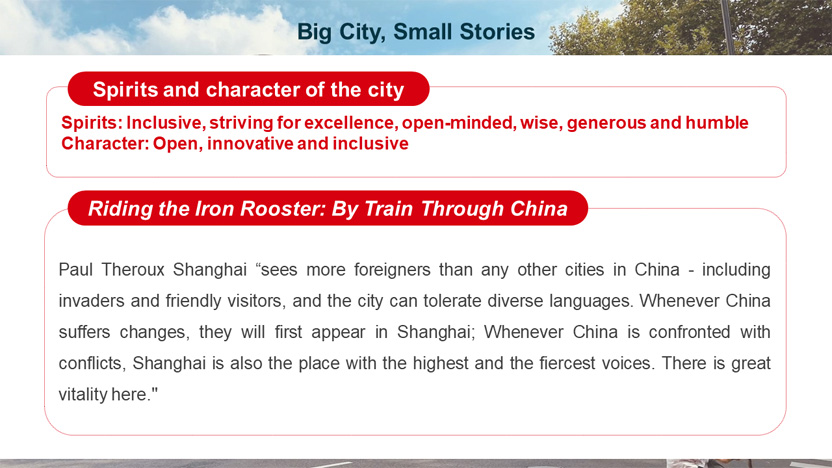
Spring Tour is based on “big” Shanghai, but we are telling “small” stories. Small stories can reach people’s hearts and make you feel the temperature, temperament and spirit of the city. These words (in PPT) represent the spirits and character of the city summarized by the General Secretary of CPC for us, which were also presented in the plenary session of CPC Shanghai Municipal Committee just held in June. I also asked our Tour Guide Management Department to convert them into stories to be told during our journey and trip. It is what the tourism industry can do and the Spring Tour can do well.
Paul Theroux, a well-known American traveler – I am reading his book Riding the Iron Rooster: By Train Through China recently – is said to be the godfather of travel literature. His words are particularly harsh, and may be unacceptable to the youth. But people who passed the 1980s in China would know that they are true, representing the real China in the 1980s. Regarding Shanghai, he wrote the following words that I wanted to share with you. He wrote that Shanghai “sees more foreigners than any other cities in China – including invaders and friendly visitors, and the city can tolerate diverse languages.” “Whenever China suffers changes, they will first appear in Shanghai; Whenever China is confronted with conflicts, Shanghai is also the place with the highest and the fiercest voices. There is great vitality here.” I think, in July 1921, something just happened in Shanghai, which shocked China at the time and from the perspective of today, shocked the world. As tourism professionals in Shanghai, we should turn our love for our hometown into more profound and considerable tourism products, designs and services. I also believe that every partner of the World Tourism Alliance will just like us, take concrete actions to bring benefits to more people with our love for tourism, hometown and motherland.
Thank you!
